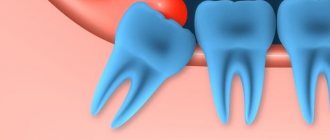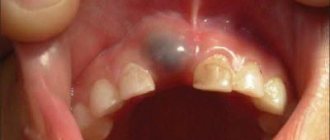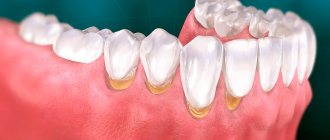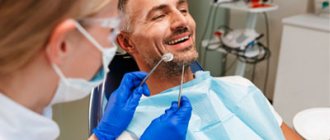Most often, a child's gums itch when baby or molar teeth begin to emerge. Some parents may assume that this process occurs at a fairly early age, 2 - 3 months, but sometimes it happens later. Read more in our article:
Sometimes the child experiences very strong painful sensations. If parents do not know how to help him, the situation becomes more complicated. There is no need to panic, the main thing is to understand the reasons for the baby’s condition. The child needs to be somehow distracted from the obsessive state, play with him, and provide first aid in the meantime.
Symptoms of sore gums
Each child experiences teething differently. The most characteristic symptoms are:
- inflammation of the gum tissue, itchy condition;
- excessive secretion of saliva (the mucous membrane secretes biological fluid to protect the inflamed area from greater damage);
- capricious behavior (the baby cries due to obvious discomfort in the oral cavity);
- disruption of the normal nature of sleep.
Other symptoms that are less common, but also characteristic of teething, are:
- increased body temperature;
- headache;
- intestinal problems (diarrhea, constipation);
- nausea, vomiting;
- difficulty breathing;
- cough.
Such conditions of the baby can seriously frighten parents. The best way out of the situation is to visit a pediatrician. In this case, a comprehensive examination of the child will be carried out, an accurate diagnosis will be made, and the medications required to be taken will be prescribed.
How to avoid making a mistake with a diagnosis?
As you can see from the information above, teething in children and serious gum disease have similar symptoms. Children's immunity is not able to protect the body from all kinds of infections and bacteria that surround the baby. Parents may be mistaken about the causes of the symptoms that appear and thereby allow a dangerous disease to progress.
The appearance of baby teeth is almost always accompanied by copious amounts of saliva and coughing. The cough caused by the disease is characterized by the presence of wheezing and sputum production.
Important! If the cough worsens over time, the doctor should examine the child for the presence of inflammatory processes in the respiratory system.
The teething process is often accompanied by diarrhea. If the diarrhea does not last long, up to three days, this is normal; if more, it’s time to contact your pediatrician. Especially when mucus or blood is found in the stool. In this case, the cause of diarrhea may be an intestinal infection.
Why do my child's teeth itch?
Smooth, moist, light pink gums are healthy. If it looks different, and there is bleeding in the mouth and an unpleasant odor is felt, the baby begins to be capricious, stops eating, and constantly scratches his teeth. In such a situation, parents should know the main sources of itching. Children's gums begin to itch for various reasons.
Allergy
A child may experience itching in the gum area when brushing their teeth with unsuitable toothpaste or eating exotic foods. Teenagers may experience an allergic reaction to installed braces.
Dental diseases of the oral cavity
Children often do not understand that it is important to practice oral hygiene, they are in a hurry when brushing their teeth or even skip this procedure in the evening.
As a result of this attitude, various gum diseases can develop. Most often, children experience the same dental diseases as adults: gingivitis, stomatitis, etc.
When itching of a child's teeth is accompanied by throbbing pain, there is a possibility of pulpitis.
Gingivitis occurs during eruption. Plaque forms and increases on the teeth, the gums turn red, and bleeding occurs. With stomatitis, blood or bluish smears, pain in the soft tissues of the mouth, and blisters appear.
Lack of vitamins
When a child does not eat enough vegetables and fruits, his body does not get important nutrients. Itchy teeth may be due to a lack of vitamin C and calcium. And the consequences of such a shortage are bleeding gums, destruction and loss of teeth (scurvy).
Other reasons
- The child is cutting a tooth. Before the age of one year, babies begin to put various objects in their mouths to scratch their teeth. At the same time, their gums may swell and bleed. Such signs appear when the baby cuts a tooth. Additional features may include high temperature, strong salivation, and clear snot. In this situation, a teether comes to the rescue. It is first frozen and then given to the baby. Ice has an analgesic effect on the gums, which begin to itch less. If the itching does not stop, then parents should consult a pediatrician to choose a medicinal ointment.
- Fungal disease. The gums may itch when a white coating develops in the mouth, which appears due to thrush (candidiasis). This fungal disease often occurs in children who taste the surrounding objects. Thrush is the result of weak immunity. To treat this disease, white plaque on tissues is often treated with a soda solution and antifungal drugs are taken while following a diet.
- Other diseases. Teeth begin to itch during colds, if swelling occurs in the mouth. In some children, weather sensitivity manifests itself through itching. If the teeth do not stop itching after long-term treatment, dentists conduct additional research and carefully study the baby’s tests. As a result, a change in composition or acidity is detected in the saliva, to which the increased immunity reacts with itching.
Choosing folk remedies
Teething at 2 months in infants is not a disease. Serious medications are not needed; sedatives, painkillers and non-strong ones are required so as not to harm the child. Folk remedies are just one of these.
Bagel for gums
- Cold is the best way to relieve itchy gums. Place a vegetable or fruit, say an apple, in the refrigerator, and then give the cold product to the little one to chew. The cold will soothe the pain and itching;
- The second way is to make a soda or saline solution. Soak gauze in it and massage the sufferer’s gums with it: the itching will begin to calm down.
When the gums itch due to illness, you should not treat the patient at home, since at this age the most common medicine can do more harm than help. Consult your doctor.
“Adam and Eve had many advantages over us, but most of all they were lucky in that they avoided teething,” which ordinary mortals, alas, have to endure. Teeth usually begin to erupt around 5–7 months, sometimes earlier, sometimes later.
To independently eliminate discomfort, when unpleasant tickling and itching in the mouth becomes unbearable, but there is no way to see a doctor for one reason or another, you should use fairly effective and safe methods:
You should rinse your mouth with water.
It should be cool or even cold. This procedure relieves swelling and inflammation.
If your gums itch due to allergies, it is important to use filtered water when rinsing. The thing is that quite often the components of running water become irritants
Dissolving ice will help relieve negative sensations for a while.
Thanks to freezing, it is possible to moisturize the oral cavity, as a result it becomes possible to eliminate repeated itching.
For resorption, you can also use frozen vegetables or fruits, and maybe berries. This method refreshes, reduces swelling and discomfort when the gums itch after tooth extraction.
The procedure should be carried out for at least a couple of minutes.
This rinse is safe when you don’t know how to help, which medicine to choose from an adult medicine cabinet if your child’s gums itch. Soda will not harm the baby's delicate body. And it is suitable for adults with sensitive oral mucosa.
Gargling with hydrogen peroxide is effective.
The same amount of peroxide is added to half a glass of warm water. Rinse your mouth for half a minute. This method can be used for no more than one and a half weeks.
You can prepare a gum paste that prevents the occurrence and spread of an irritating infection.
You need to mix a spoonful of baking soda with water - a couple of drops is enough. You should get a paste-like mixture.
Aloe lotions are effective for relieving gum inflammation.
The sheet is cut and applied to the affected area. Only fresh plants should be used.
It is very important to exclude sour and spicy foods from your diet during treatment. This applies to peppered and smoked delicacies
Citrus fruits, coffee, and other drinks should be added to the list. You should only drink plain water.
What to do
Parents should always ensure that their child brushes their teeth thoroughly in the morning and evening after meals.
If your gums still start to itch, you should immediately purchase a brush with soft bristles and medicated paste.
This way you can determine whether the itching is an allergic reaction of the body.
You also need to pay attention to the foods your baby eats. Introduce more fruits and vegetables into your diet, this is especially important in the spring. Serve only warm food, because... hot increases gum irritation.
After brushing your teeth, rinse your mouth with herbal decoctions and medical solutions.
Folk remedies for pain relief
Pain and discomfort during teething can be overcome very quickly and effectively using various folk remedies. All of them are simple, accessible and easy to use. Here are the most popular folk remedies for treating teething and eliminating unpleasant symptoms:
Soothing warm tea. It can be drunk by both adults and children. Properly prepared tea has a pronounced calming effect and also significantly relieves pain. To prepare tea, you will need to take chamomile, lemon balm, lavender or catnip in equal quantities. A tablespoon of the resulting mixture is poured into a glass of boiling water and infused for 15 minutes. You need to take the product after straining. The advantage of this tea is that it can be taken in absolutely any quantity, since the composition is classified as safe; Clove oil. This product is characterized by a unique analgesic effect and reduces inflammation in the gums. Pure oil can burn your gums a little, so before use the product must be diluted in a ratio of one and a half to one. The product should be diluted not with water, but with almond or olive oil; Chamomile. The herb has an ideal analgesic and calming effect. A more concentrated composition can be rubbed into the gums, and a diluted one can be drunk, even for children; Valerian. The product has a calming effect. This remedy can be used by adults, since the herb is infused with brandy during the preparation process. To prepare the solution, you need to crush 30 grams of valerian roots to a powder and then pour half a glass of brandy over everything. The product is infused for three days, and then the resulting composition can be lubricated on the gums. The product ideally relieves itching and mild pain; Chicory or strawberry roots. These roots can be given to a child to chew to quickly get rid of pain and quench annoying itching; Sage. During teething, babies can be given a weak decoction of sage. The composition can simply be rubbed into the gums, thereby not only eliminating all unpleasant phenomena, but also strengthening the gums and teeth. The decoction can be added to the bath when bathing and thereby achieve a high calming effect; Herbal tea based on lemon balm, lavender, chamomile, catnip and primrose. A spoonful of the resulting mixture is poured with a glass of boiling water and infused for 30 minutes. This tea can completely replace water for a child. The baby will not be capricious or cry after taking it; The gums can be treated with a composition of chamomile, chickweed and burdock roots. Plants must be infused with water. This product can also be used by adults; Shilajit gives a powerful analgesic effect. Finding this Altai folk remedy is not difficult; it is sold in every pharmacy; Propolis. The product is ideal for adults and children. To prepare a useful medicinal product, you will need to take the substance and dissolve it in a small amount of water.
You can not only wipe your gums with the product, but also take the composition internally; Lubricating the gums with honey helps a lot; it is important that there is no allergy to this product.
To achieve a lasting positive effect, it is worth supplementing these treatment methods with simple rules that will alleviate the general condition. You need to sleep on a slight elevation. This will drain blood from the gums, so they will be much less bothersome.
It is also worth finding a means that will effectively distract you during a difficult period. For kids, this could be an interesting toy, book or cartoon.
Rinses to help relieve itching
Teeth stop itching if you treat the oral cavity with solutions containing soda or salt.
In folk medicine, decoctions are used:
- sage;
- oak bark;
- chamomile flowers.
A tablespoon of herbs is poured into a glass of boiling water and cooled to room temperature. The resulting decoction is filtered and used for rinsing the mouth. The procedure should be performed up to 6 times a day.
It is usually difficult for children to explain what is bothering them, so parents should themselves examine the baby’s teeth, gums and tongue from time to time. If, during such an examination, an adult discovers signs of illness in the child’s mouth, then you should immediately contact a dentist.
How often do you look into your baby's mouth? Many parents are sure that it is enough just to control that the child is not lazy to brush his teeth before bed and in the morning. And some don’t even have time to do this. Otherwise, adults follow the logic: since the child does not cry and eats ice cream with a wide smile, then everything is fine.
But, for example, gingivitis in children can be almost painless. At first. But if the sore is neglected without paying attention to it, there is a risk of facing very, very unpleasant consequences - even losing teeth!
Let's figure out what kind of illness this is, how to detect it and cure it.
When problems knock on the door
The symptoms listed above relate not only to teething, but also accompany other, more dangerous diseases and phenomena. During the first months of life, the child’s body grows, develops and is not yet able to effectively repel infections. A baby can get sick, and for adults who are far from medicine, it’s easy to confuse a dangerous illness with teething. Take your baby to a doctor to find out exactly the cause of his suffering.
When teething, excessive salivation occurs and coughing up drool is common. However, if the cough is wet, with wheezing and phlegm, then this is clearly a sign of a serious illness.
When teeth begin to erupt, newborns' body temperature rises.
Visit a doctor if the temperature exceeds 38 or if it does not subside for several days.
Diarrhea is common and occurs due to excessive salivation.
When the diarrhea goes away quickly, it’s okay, but if it continues for more than two or three days, or if blood or mucus has been spotted in the stool, it’s time to see a doctor. A runny nose is one of the signs of teething and is not worth worrying about, except in cases of severe swelling, congestion, or blowing out green mucus. In all cases, it is better for the baby to be checked by a doctor.
Massage gums during teething
Symptoms of gingivitis in children
Gingivitis in children is an inflammatory disease that affects the gum tissue adjacent to the teeth and located in the spaces between them. Remember: have you ever noticed blood on your toothbrush? This is just one of the first symptoms of gingivitis. This also includes: redness and swelling of the gums, pain during brushing, gum hypertrophy (overgrowth), high fever.
“There are five types of gingivitis: catarrhal, ulcerative-necrotic, hypertrophic, atrophic, desquamative,” lists pediatric dentist Suleiman Ibragimov. – And each has its own symptoms. For example, catarrhal gingivitis may not manifest itself in any way, except that when brushing your teeth, weakened gums begin to bleed. With other variations of the disease, everything is more serious.
During ulcerative necrotic gingivitis, the gums itch and hurt. In addition, the temperature may rise and the lymph nodes may become inflamed. The process is accompanied by general malaise and increased salivation, and after a while ulcers appear and gum tissue begins to die.
Hypertrophic gingivitis in children, symptoms: gums increase in size, bleed heavily, pain develops into constant pain. The hypertrophied tissue gradually grows so much that it “crawls” onto the teeth. Well, underneath is the kingdom of pathogenic microflora, which is extremely difficult to combat.
Atrophic gingivitis in children manifests itself in the fact that the teeth become very sensitive, as the gums seem to be depleted, decrease in volume, and the necks of the teeth and even the roots are exposed. According to Suleiman Ibragimov, at this stage the disease enters its most severe stage: it is no longer gingivitis, but practically periodontitis, that is, the process moves to the jaws.
The appearance of desquamative gingivitis is indicated by purulent blisters on the surface of the gums, as the upper layer of the mucous membrane is destroyed.
Traditional methods
Non-drug ways to relieve teething symptoms are usually used for mild discomfort; in particular, this includes:
- gum massage It is carried out with a clean finger and light movements to avoid tissue injury. Helps improve blood circulation in the gums and stimulate the teething process;
- use of teethers. A wide variety of these toy devices are presented. They can be rubber, silicone, plastic, gel, with a cooling effect (they can be frozen before use), with different types of surface;
Silicone teether
- the use of cold, which helps relieve irritation and swelling. You can freeze a damp cotton cloth in the refrigerator and give it to your baby to chew on, or you can do the same with a pacifier or a special teether.
The following traditional methods should not be used for safety reasons:
- pressing with a finger on the eruption area. This will not speed up the process of tooth emergence, but may provoke increased pain;
- treat the gums with undissolved soda, and also pick them out. In this case, there is a risk of infection;
- give your baby stale bread, cookies, carrots. This method is an alternative to teethers.
Treatment of gingivitis in children
“In children suffering from gingivitis, as a rule, at the appointment we find a thick layer of plaque and hard deposits, as well as caries that affects many teeth at once,” notes Dr. Ibragimov.
A key role in the development of gingivitis is played by bacteria that multiply in dental plaque. In addition, the appearance of sores is facilitated by: infections (such as acute respiratory viral infections or chronic tonsillitis, for example), allergic diseases, hypovitaminosis, diabetes, problems of the digestive system, and so on. If your child has an incorrect bite, the child diligently avoids the toothbrush or brushes his teeth incorrectly - all this can also affect the occurrence of gingivitis.
Have you noticed your baby’s gums are red and slightly swollen? This may already be the first call. And coupled with a high temperature indicates a serious inflammatory process. See a doctor urgently! Until this moment: bed rest, drinking plenty of fluids, if necessary, antipyretic drugs (Ibuprofen, Paracetamol).
– Gingivitis must be treated comprehensively, taking into account the individual characteristics of each little patient. To begin with, find and eliminate the cause: for example, cure caries, tonsillitis (other common diseases), or deal with malocclusion pathologies, says Suleiman Ibragimov.
Then comes the treatment of gum inflammation itself. It is carried out in stages:
- removal of soft plaque and hard dental deposits;
- a course of anti-inflammatory procedures: rinsing the mouth with antiseptics (for example, Miramistin) and herbal decoctions (eucalyptus, sage or regular chamomile are suitable). You need to rinse your mouth after each brushing of your teeth, twice a day. For the youngest (who do not yet know how to rinse their mouth, and there is nothing to clean there yet), the doctor will prescribe applications with a gel containing cetalkonium and choline salicylate, plus treatment of the oral mucosa with antiseptics.
- additionally: vitamins, limit carbohydrates, enough fruits and vegetables.
“The duration of treatment depends on the form and severity of the disease,” explains Suleiman Ibragimov. — In the initial stage, the development of gingivitis in children can be stopped in 5-7 days. A severe form of the disease will have to be treated for about a month.











